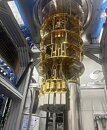
Fujitsu and RIKEN Develop World-Leading 256-Qubit Superconducting Quantum Computer
Fujitsu Limited and RIKEN today announced the development of a world-leading 256-qubit superconducting quantum computer, established at the RIKEN RQC-FUJITSU Collaboration Center. This new quantum computer builds upon the advanced technology of the 64-qubit iteration, launched with the support of the Japanese Ministry of Education, Culture, Sports, Science and Technology (MEXT) in October 2023, and incorporates newly-developed high-density implementation techniques. This announcement marks another crucial step toward the practical application of superconducting quantum computers and unlocking their potential to grapple with some of the world's most complex issues.
Both organizations will integrate the 256-qubit superconducting quantum computer into its platform for hybrid quantum computing lineup and offer it to companies and research institutions globally starting in the first quarter of fiscal 2025. The platform's expansion from 64 to 256 qubits empowers users to tackle more complex challenges, including the analysis of larger molecules and the implementation and demonstration of sophisticated error correction algorithms.
Both organizations will integrate the 256-qubit superconducting quantum computer into its platform for hybrid quantum computing lineup and offer it to companies and research institutions globally starting in the first quarter of fiscal 2025. The platform's expansion from 64 to 256 qubits empowers users to tackle more complex challenges, including the analysis of larger molecules and the implementation and demonstration of sophisticated error correction algorithms.








































